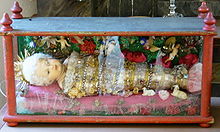Fatschenkind
A Fatschenkind , also Fatschenkindl , Fatsche , Windelpaket , Büschel (Sudetenland), "Toys" (in South Tyrol), is a devotional image or a votive image of the Baby Jesus , which was particularly widespread in southern Germany and Austria. The portraits wrapped with ribbons ("faked") are mostly made of wax , but there are also fatsch children made of wrought iron or painted wood.
Derivation

The Gospel of Luke describes the baby Jesus wrapped in diapers ( Lk 2.7 EU ). The depiction as a fat child (from Latin fascia , "bandage", "wrapping tape"), which has been common since the 3rd century , shows a widespread method of infant care. The entire body of the child and the arms are wrapped with ribbons. Fattening infants was common in German-speaking countries until the 19th century. The baby Jesus was represented accordingly.
Customs and art history
In the Middle Ages it was customary to give figures of the baby Jesus to novices , and nuns made such votive pictures. Preciously clad and sometimes protected in glass boxes, Fatschen children were supposed to serve personal piety. From its use as a devotional picture in the cell , the nickname "little comforter" arose.
A Fatschenkind also belonged to the custom of the child's cradle , which has been documented since the Middle Ages and into the 19th century : the crib in which a Fatschenkind lay was set up in the church . Children danced in front of him and sang Christmas carols, while the baby Jesus was rocked in the manger or passed from arm to arm. The song Joseph, dear Joseph mein, from the 14th century was particularly popular . This custom was intended to clearly illustrate the incarnation of Christ . Alsatian votive offerings in the shape of a Fatschen child showed the suggestion of a skeleton or at least the ribs.
On Christmas Eve , a Fatschenkind was set up in the houses in Herrgottswinkel . It was a wax figure encased in silk, lace and ruffles in a small framed wooden box with a pane of glass on the front. The body was usually formed by a flat roller of fabric or paper. The inside walls of the box are lined with colored paper, sometimes with embroidered silk, stones and pearls. These boxes were mostly made in monasteries.
The representation of the Fatschenkind was also in use as a baking pan for breads .
Cradle (1585) with Fatschenkind of the 18th century ( Bavarian National Museum , Munich)
Ex voto offered Fatschenkind made of wax in the Mühlviertel Castle Museum
See also
literature
- Stefan Hirsch (Ed.): Connected to life. Volume 3: Fatschenkinder. Lectures at the conference “Linked to life” from November 19 to December 1, 2002 in the Seeon monastery (culture and education center of the Upper Bavaria district) on the occasion of the two exhibitions “Historical Fatschenkinder” and “Painting by Eckart Hahn”. District of Upper Bavaria - specialist advice on home care, Benediktbeuern 2005, ISBN 3-8306-7140-7 .
- Alfred Fuchs: Folk Art. In: Paul Praxl (ed.): The district of Freyung-Grafenau. Verlag Freyung-Grafenau, Freyung 1982, ISBN 3-87553-192-2 , pp. 279-292.
Web links
- Johann Werfring: A superscript blue Fatschenkind article in the “Wiener Zeitung” from March 31, 2011, supplement “ProgrammPunkte”, p. 7




